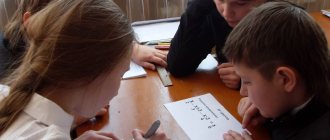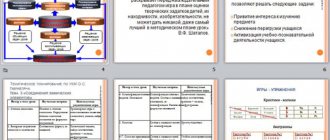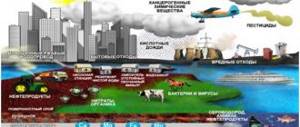Implementation of a system-activity approach in geography lessons
IMPLEMENTATION OF A SYSTEM-ACTIVITY APPROACH IN GEOGRAPHY LESSONS
I hear and forget
I see and I remember,
I do it and I understand.
Chinese wisdom
When developing federal state standards of the second generation, the priority of general education becomes the formation of general educational skills, as well as methods of activity, the level of mastery of which largely determines the success of all subsequent education. Currently, the use in teaching of techniques and methods that form the ability to independently obtain new knowledge, collect the necessary information, put forward hypotheses, draw conclusions and inferences is becoming increasingly relevant in the educational process.
General didactics and specific methods within each academic subject, and geography in particular, call for solving problems related to the development of students’ skills and abilities of independence and self-development.
“A bad teacher presents the truth, but a good teacher teaches how to find it” -
This statement by A. Disterweg is known to everyone. However, is this provision fully used in relation to school geography?
Appealing to the student’s personality cannot by itself lead to the implementation of developmental teaching ideas in geography lessons. The amount of knowledge given to a student outside of his activities, without taking into account his “internal” content, cannot lead to the development of personal qualities, much less the creative abilities of the student.
The goal of a modern school is not so much the enrichment of knowledge,
how much mastery of methods of activity The ability of a geography teacher to organize the educational activities of students in the practical application of their existing theoretical knowledge and independent acquisition from various sources of new knowledge necessary to solve assigned problems plays a great role in improving the quality of geographical education.
I think you will agree with me that the actual quality of organization of educational activities in geography lessons is currently the main criterion for assessing the success of a lesson, and the system-activity approach is becoming the methodological basis for a modern geography lesson. The quality of students' geographical knowledge acts as an evaluative criterion for the teacher's work as a whole.
Various forms of independent use of a system of tasks and exercises in geography enable students to apply their theoretical knowledge in practice, in the process of direct educational activities, and to develop the geographical skills they need. The implementation of a system-activity approach in the process of teaching geography makes it possible to achieve high quality geographical education and prepare students to use their geographical knowledge in real life and practical activities.
It is no secret that knowing the definition of the geographical concept of “azimuth” will not help you find the right road in an unfamiliar area if, when studying geography at school, practical skills in orienting the area using a map, plan, compass, and local signs have not been developed etc.
Theoretical knowledge without the ability to apply it in practice remains a dead weight, overloading students' memory with information they do not need.
Therefore, today it is important not so much to give a child as much knowledge as possible, but to ensure his general cultural, personal and cognitive development, and equip him with such an important skill as the ability to learn. In fact, this is the main task of the new educational standards, which are designed to realize the developmental potential of general secondary education. The system-activity approach helps to constructively fulfill the tasks of education of the 21st century.
System-activity approach
is a teaching method in which the student does not receive knowledge in a ready-made form, but obtains it himself in the process of his own educational and cognitive activity.
The fundamental difference between the technology of the activity method and the traditional technology of the demonstration-visual teaching method is that the proposed structure describes the activity of students, not the teacher.
The implementation of the activity method technology in practical teaching is ensured by the following system of didactic principles:
Operating principle
— lies in the fact that the student, receiving knowledge not in a ready-made form, but obtaining it himself, is aware of the content and forms of his educational activities, understands and accepts the system of its norms, actively participates in their improvement, which contributes to the active successful formation of his general cultural and activity abilities, general educational skills.
Continuity principle
— means continuity between all levels and stages of education at the level of technology, content and methods, taking into account the age-related psychological characteristics of children’s development.
Principle of integrity
— involves the formation in students of a generalized systemic understanding of the world (nature, society, oneself, the sociocultural world and the world of activity, the role and place of each science in the system of sciences).
‘
Minimax principle
— is as follows: the school must offer the student the opportunity to master the content of education at the maximum level for him (determined by the zone of proximal development) and at the same time ensure its mastery at the level of a socially safe minimum (state standard of knowledge).
The principle of psychological comfort
— involves the removal of all stress-forming factors of the educational process, the creation of a friendly atmosphere at school and in the classroom, focused on the implementation of the ideas of cooperative pedagogy, and the development of dialogue forms of communication.
The principle of variability
— involves students developing the ability to systematically enumerate options and make adequate decisions in situations of choice.
The principle of creativity
- means maximum focus on creativity in the educational process, students’ acquisition of their own experience of creative activity. One of the main tasks of a geography teacher is to organize educational activities in such a way that students develop the need to creatively transform educational material in order to master new knowledge. In order for students’ knowledge to be the result of their own searches, it is necessary to organize these searches, manage students, and develop their cognitive activity.
Teacher position:
to the class not with an answer (ready-made knowledge, abilities, skills), but with a question (“What facts are there?”, “What surprised you? What interesting things did you notice?”)
Student position:
for knowledge of the world (in specially organized conditions for this).
Learning task
- a task in which the child completes the teacher’s assignments. It may or may not coincide with the purpose of the lesson.
Educational activities
- controlled educational process.
Learning action
- the action of creating an image.
Image
- word, drawing, diagram, plan.
Evaluation action
- "I can! I can do it!”
Emotional value assessment
- “I believe that...”
(formation of worldview).
| Teacher action — | Student action |
| 1st stage Updating students' knowledge, presenting a problem situation | 1st stage Strengthens the ability to analyze, generalize, and formulate conclusions |
| 2nd stage Organizes student interaction, organizes solutions, collection and discussion of results in pairs | 2nd stage Application of the obtained knowledge in modified conditions (working in pairs), implementation of mutual control |
| 3rd stage Organizes a search for a rational way to solve a learning problem, independent completion of tasks by students, self-checking of their decisions | 3rd stage Strengthens the ability to work independently and control the correctness of one’s actions |
| 4th stage Control and correction of knowledge, providing the opportunity to identify the causes of errors and correct them | 4th stage Application of the obtained knowledge in practice |
| 5th stage Monitoring the results of educational activities, assessing knowledge | 5th stage Self-summarizing the lesson, self-analysis and self-assessment |
Educational and activity-oriented lessons on goal setting can be divided into four groups:
- Lessons in the “discovery” of new knowledge.
- Reflection lessons.
- Lessons of general methodological orientation.
- Lessons in developmental control.
- A lesson in “discovering” new knowledge
Activity goal:
formation of students' ability to a new way of action.
Educational goal:
expansion of the conceptual base by including new elements into it.
- Reflection lesson
Activity goal:
developing in students the ability to reflect on correctional-control type and implement correctional norms (fixing their own difficulties in activities, identifying their causes, constructing and implementing a project to overcome difficulties, etc.)._
Educational goal:
correction and training of learned concepts, algorithms, etc.
- Lesson of general methodological orientation
Activity goal:
formation of students’ ability to a new way of action associated with building the structure of the studied concepts and algorithms.
Educational goal:
identifying the theoretical foundations for constructing content and methodological lines.
- Developmental Control Lesson
Activity goal:
formation of students' ability to carry out control functions.
Educational goal:
control and self-control of learned concepts and algorithms.
The theoretically based mechanism of control activities involves: presentation of a controlled option; the presence of a conceptually justified standard, rather than a subjective version; comparison of the tested option with the standard according to the agreed mechanism; assessment of the comparison result in accordance with a previously justified criterion. The division of the educational process into lessons of different types in accordance with the leading goals should not destroy its continuity, which means it is necessary to ensure the invariance of the teaching technology. Therefore, when constructing a technology for organizing lessons of different types, the activity-based teaching method must be preserved and a corresponding system of didactic principles must be provided as the basis for constructing the structure and conditions of interaction between teacher and student.
The technology of the system-activity method involves the following sequence of steps in the lesson:
- Motivation (self-determination) of educational activities.
This stage involves the student’s conscious entry into the educational space.
activities in the lesson. At this stage, the student’s positive self-determination for activities in the lesson is organized, namely:
the requirements for it from the side of educational activities are updated (“must”); conditions are created for the emergence of an internal need for inclusion in educational activities (“I want”); a thematic framework (“I can”) is established.
- Updating knowledge and fixing individual difficulties in a trial action.
This stage involves preparing children’s thinking for the designed activity, organizing preparation and motivation of students for proper independent implementation of a trial educational action: 1) updating knowledge, skills and abilities sufficient to build a new way of action; 2) training of appropriate mental operations. At the end of the stage, a difficulty is created in the individual activities of the students, which is fixed by them themselves.
- Identifying the location and cause of the problem.
At this stage, the teacher organizes for students to identify the place and cause of the difficulty: 1) the restoration of completed operations is organized and the location, step, where the difficulty arose is recorded; 2) identifying the cause of the difficulty - what specific knowledge and skills are missing to solve the original problem of this class or type.
- Construction of a project for getting out of a difficulty (“discovery” of new knowledge by children).
At this stage, students communicatively consider the project of future educational activities:
- set a goal; 2) build a plan to achieve the goal; 3) students are expected to choose a method for resolving a problem situation and, based on this method, means (algorithms, models, textbook); 4) building a plan to achieve the goal.
- Implementation of the constructed project.
At this stage it is necessary to organize:
1) solving the initial problem (various options proposed by students are discussed, and the optimal option is selected, which is recorded in the language verbally and symbolically);
- record overcoming the difficulty;
- clarification of the nature of new knowledge.
- Primary consolidation with pronunciation in external speech.
Organize children’s assimilation of a new method of action when solving standard problems with their pronunciation in external speech. (Frontally, in pairs or groups)
- Independent work with self-test according to the standard.
Organize independent completion of tasks by students for a new method of action, self-test based on comparison with the standard. The emotional focus of this stage is to organize, if possible, a situation of success for each student, motivating him to engage in further cognitive activity.
- Inclusion in the knowledge system and repetition.
Organize the identification of the boundaries of application of new knowledge, repetition of educational content necessary to ensure meaningful continuity.
- Reflection on learning activities in the lesson (result).
“...Then judge yourself,” said the king. - This is the most difficult thing. Judging yourself is much more difficult than judging others. If you can judge yourself correctly, then you are truly wise.” Organize students' assessment of their own activities, organize recording of unresolved difficulties in the lesson as directions for future educational activities, organize discussion and recording of homework.
Advantages of the system-activity approach in teaching geography
- The nature of learning changes from memorizing concepts to understanding them.
- The time required to study the material is reduced.
- The motivational and value sphere of the individual develops.
- Conscious cognitive motivation is formed.
- The developmental goals of the lesson are being realized.
Thus, the use of a system-activity approach in geography lessons creates the necessary conditions for the development of students’ abilities to think independently, analyze, select material, navigate a new situation, and find ways of working to solve practical problems.
LITERATURE
- Kubysheva M. A.
Implementation of activity method technology in lessons with different target orientations. - M., 2005.
Peterson L. G.
Activity-based teaching method. — M.: ACADEMIA APK and PPRO, 200
DEPARTMENT OF EDUCATION OF PETROVSKY DISTRICT COUNCIL IN DONETSK
DONETSK COMMON EDUCATION SCHOOL I – III STAGES No. 108
DONETSK CITY COUNCIL OF DONETSK REGION
REPORT ON THE TOPIC
«IMPLEMENTATION OF A SYSTEM-ACTIVITY APPROACH IN GEOGRAPHY LESSONS"
Prepared
geography teacher
highest category
Demidova N.E.
Donetsk
Material for geography teachers “A brief historical overview of the development of the activity approach”
Brief historical overview of the development of the activity approach
During the period of socio-economic transformations in our country, society’s demands for the development of the creative powers and abilities of each individual, for the preparation of the younger generation for active socially useful and cognitive activities are increasing significantly. In this regard, educational aspects should shift from mastering the fundamentals of science to the development of the student’s personality, capable of mastering creative, constructive thinking.
The concept of “learning through activity” was proposed at the beginning of the 20th century by the American scientist and philosopher John Dewey. His ideas are described in detail in the book “Democratization and Education” (1916). The basic principles of his system: taking into account the interests of students; learning through teaching thought and action; cognition and knowledge are a consequence of overcoming difficulties; free creative work and cooperation. In our country, this concept was developed in the first half of the 20th century. In the studies of L.S. Vygotsky, A.N. Leontyev and S.L. Rubinstein and turned into a well-founded theory of teaching that has received wide recognition in the world.
There are different dates for the emergence of the concept of the activity approach, associated with different points of view on the authorship of the theory of activity. Some researchers, for example, A.V. Brushlinsky, believe that the principle of activity was formulated by S.L. Rubinstein back in 1922 in his article “The Principle of Creative Amateur Performance,” while in Soviet psychology in the 1920s - early 1930s The “non-activity approach” prevailed, represented, in particular, by the school of L.S. Vygotsky. Other researchers have established that M. Ya. Basov was the first to introduce the concept of activity into the development of psychological problems. True, A.N. Leontyev believed that, unlike L.S. Vygotsky, who did not use the term “activity”, but in fact his concept was “activity”, M.Ya. Basov used exactly this term, but did not put psychological content into it.
Regardless of the dispute about priorities, it is necessary to point out that the basis of the psychological theory of activity is the postulate of Marxist dialectical-materialist philosophy that it is not consciousness that determines being and activity, but, on the contrary, being and the activity of a person determine his consciousness. Based on this position, S. L. Rubinstein in the 1930s. the principle of the unity of consciousness and activity was formulated. “Forming in activity, the psyche, consciousness manifests itself in activity. Activity and consciousness are not two aspects facing in different directions. They form an organic whole, not identity, but unity.”
A. N. Leontyev proposed a different solution to the problem: the psyche, consciousness “lives” in activity. That is, consciousness does not simply manifest itself and form in activity as a separate reality - it is “built-in” into activity and is inseparable from it.
The differences between the two variants of the activity approach were clearly formulated in the 1940-1950s. and affect mainly two circles of problems.
This is a problem in the subject of psychological science. From the point of view of S. L. Rubinstein, psychology should study not the activity of the subject as such, but “the psyche and only the psyche,” however, through the prism of activity. A. N. Leontyev, on the contrary, believed that activity must inevitably be included in the subject of psychology, since the psyche itself is a form of objective activity.
In accordance with this view, an indispensable condition for the effectiveness of education in the context of the activity approach is reliance on the child’s own strengths, on the internal logic of his development, on that layer of human existence that is called the spirit. The same view allows us to see the activity approach to education as a personality-oriented approach .
The activity approach was most intensively developed and at the same time most productively used in such an area as education. Moreover, the advantage here clearly belongs to the followers of A. N. Leontiev’s school.
So, according to the concept of “learning through activity” developed by foreign and domestic researchers, activity and consciousness are two closely related aspects of personality that closely interact in the learning process. At the same time, it is the activity aspect that is the leading one, determining the consciousness of the student.
The concept of a system-activity approach was introduced in 1985 as a special kind of concept. By this they tried to remove the opposition within Russian psychological science between the systemic approach, which was developed in the studies of the classics of Russian science (such as B.G. Ananyev, B.F. Lomov, etc.), and the activity approach, which has always been systemic (it was developed by L. S. Vygotsky, L. V. Zankov, A. R. Luria, D. B. Elkonin, V. V. Davydov and many others). The system-activity approach is an attempt to combine these approaches.
Regarding general secondary education, back in 1988, a group of domestic scientists argued: “the activity approach focuses not only on the acquisition of knowledge, but also on the methods of this acquisition, on patterns and methods of thinking and activity, on the development of the cognitive powers and creative potential of the child. This approach opposes verbal methods and forms of dogmatic transmission of ready-made information, the monologue and impersonality of verbal teaching, the passivity of schoolchildren’s learning, and finally, the uselessness of the knowledge itself, skills and abilities that are not realized in activity.”
According to the concept of L.S. Vygotsky, the processes of teaching and upbringing do not directly develop the child in themselves, but only when they have activity forms and have appropriate content. Between learning and mental development of a person, his activity always stands. Properly organized training is one that runs ahead of development by creating zones of proximal development.
The works of E.N. are devoted to identifying the stimulating influence of training on development and studying the problems of transferring acquired knowledge and skills to other areas. Kabanova-Meller, T.P. Gerasimova and others. The essence of their work is the study of the mechanism of assimilation of knowledge and skills, or, using their term, methods of educational work. As a result, it was proven that students master a method of educational work if, firstly, they know the method of action and, secondly, they know how to apply this technique when solving educational problems. Of course, this concept has played a huge positive role in improving the theory and practice of developmental education and has had a great influence on the quality of teaching geography in recent decades.
Evgenia Nikolaevna Kabanova-Meller devoted many monographs and articles to solving one of the most important pedagogical problems - improving the quality of school education. The principles of developmental education have received universal recognition, ensuring the consciousness of learning, the activity of students, and the possibility of their independent work.
In our study of the problems of developmental education, we proceeded from the position that it should be built on an activity basis and ensure the mental development of schoolchildren. In our case, the activity-based approach to teaching acts as a universal method of developmental education, which has a solid theoretical research base, which is based, first of all, on fundamental works in the field of philosophy and psychology.
The psychological foundations of the theory of activity are set out in the works of D.V. Davydova, L.S. Vygotsky, A.N. Leontyeva, S.L. Rubinshteina, D.B. Elkonina. The merit of domestic scientists is that they managed to creatively rethink the enormous philosophical and psychological heritage of various schools and traditions in understanding mental phenomena and develop a fundamentally new scientific approach to the psychological study and formation of human consciousness and activity.
The fundamental idea of the activity approach in psychology is the principle of the unity of consciousness, activity and personality (A.N. Leontyev and S.L. Rubinstein), the essence of which is that the human psyche manifests itself and is formed in activity - work, education, play, etc. .
The activity approach to the educational process has found wide application in the pedagogy of primary and higher schools. At the same time, there is a clear lag in the use of pedagogical technologies applied on the basis of activity theory in the second and third levels of school. Therefore, today the secondary school as a whole is not yet ready to accept children who studied in primary school under this system, i.e. according to developmental education programs D.B. Elkonina - V.V. Davydov, since they are noticeably different in their educational potential from their peers who studied in traditional programs. This circumstance makes research relevant in terms of its continuity, consistency, universality and manufacturability. The lack of software and methodological support, limited experience in using activity-based developmental learning technology at the middle and senior levels of school, and insufficient systematization of practice in this direction of improving the educational process slow down the search for basic guidelines in solving this problem. It still remains relevant for organizing the educational process in secondary schools, including teaching geography.
However, we believe that the activity approach applies not only to “Davydov” or “Zankov” developmental education. Any educational system has its own system of activities. Developmental education is an integral pedagogical system that differs from the traditional one in a special type of content - activity content, a special type of student activity - educational activity, a special type of collective communication - collective distribution activity, etc. For each activity there are corresponding universal learning activities.
The current software and methodological support for basic school academic disciplines is focused on the formation of the traditional triad for didactics - knowledge, skills and abilities, which clearly does not contribute to the development of the creative potential of the individual. Therefore, the most important practically significant task facing the school is the transition to a new content of education, providing a solution not to the twofold (teaching and educational), but to the triune (teaching, educational and developmental) task. A qualitatively different level of education can be achieved not so much through modernization and improvement of existing educational structures, but rather by changing the approach to the content and technology of education, building a personality-oriented model aimed at shaping the educational activities of schoolchildren.
The transformations that took place in the life of our society after 1917 were also reflected in the school, the activities of which were strictly determined by the Communist Party and the state. In the early 1920s, teaching trends on a local history basis prevailed in school geography; the interpretation of phenomena occupied a large place in the content of courses; nature and social life began to be explained from a materialistic point of view.
The program’s methodological recommendations contained many good proposals, for example, about special attention to working with a map, about relying on local history material at the beginning of the course and the importance of excursions, about studying nature in connection with human economic activities, etc. But most of these recommendations were It was impossible to implement in practice due to the short time allocated to studying geography and the lack of teaching aids and maps. Not a single hour was allocated for practical work, exercises and excursions. It was necessary to pay more attention to practical work, as well as invest more money in their implementation.
Despite the major shortcomings in teaching geography in the late 20s and early 30s, there were also serious methodological achievements. The geography course program had a clearly expressed local history principle. The implementation of this principle is not possible in practice without familiarization with it on the ground. Thanks to this, excursions have become important in teaching practice. The use of the excursion method in practice made it possible to acquaint students not only with geographical objects in nature and the economy, but also with natural and economic processes that students could understand.
Various forms of extracurricular activities have acquired much greater importance than in pre-revolutionary times, which was greatly facilitated by the general rise in social activity in the country (subject clubs by grade, school-wide evenings, themed evenings based on excursion materials, hikes, question and answer evenings, geographical quizzes, theatrical staging of geographical events, etc.). All this increased interest in geography and, like excursions, became firmly established in school practice and enriched the methods of teaching geography.
“Workbooks” with tasks for independent exercises in the classroom and at home are widely used and used in practice.
Despite the above innovations in the methodology of teaching geography, the content of the subject needed to be improved.
Back in the 20s of the last century, geography did not exist as an independent subject in school. It was only part of the content of social science and natural science. And only on May 15, 1934. By a special resolution of the Council of People's Commissars of the USSR and the Central Committee of the All-Union Communist Party of Bolsheviks "On the teaching of geography in primary and secondary schools of the USSR", the subject "geography" became an independent discipline. The teaching of geography in schools after 1934 has been steadily improved over the years.
Until the mid-50s, in the methodology of teaching geography, there was an endless search for ways to improve the organization of schoolchildren’s activities. Basically, the influence of the ideas of progressive teachers (M.N. Skatkin, L.V. Zankov, V.V. Kraevsky and many other specialists) can be traced. Much attention was paid to practical work on the ground and observations, work on a geographical site, and setting up experiments. In the methodology of geography, the central figures on practical work are A.S. Barkov, A.A. Polovinkin, V.G. Erdeli.
By the mid-50s - late 60s, the development of geography methods in the Soviet school became associated with the introduction of new programs and tasks for polytechnic education.
In 1956, it was noted that the biggest drawback in the educational work of schools is the separation of education from life, the insufficient preparedness of school graduates for practical activities. It was considered necessary to rebuild the secondary school curriculum towards greater industrial specialization, so that boys and girls graduating from the ten-year school would have a good general education, opening the way to higher education, and at the same time be trained in practical activities, since the majority of graduates will immediately get involved in work in various sectors of the national economy. In this regard, practical work was included in the geography program for the first time (!), which increased teachers’ attention to methods and forms of organizing training. Organizational forms should ensure the connection of training with productive work. Teaching methods should be aimed “at the conscious and active assimilation of knowledge, skills and abilities, the skillful application of knowledge to solve practical problems and, at the same time, the comprehensive development of the cognitive powers and abilities of students.”
In the 60s and 70s of the twentieth century, the practical orientation in geography underwent a number of significant changes. Of particular note are the achievements of the methodology, which are of great importance in the practice of teaching geography.
By the 70s, geography became one of the fundamental sciences that solved the most complex theoretical problems of the relationship between nature and society, as well as practical problems of rational use of natural resources, planning the development and location of production in our country, economic relations with foreign countries, problems of nature conservation, etc. d.
The formation and development of practical orientation in the methodology of geography continued. In the 70s and 80s, fundamental methodological manuals were published, which contained psychological and pedagogical justifications, specific methodological developments for organizing and conducting practical work (A.E. Bibik, V.A. Korinskaya, L.M. Poncheshnikova, T. P. Gerasimova, I. S. Matrusov, M. K. Kovalevskaya, V. A. Shchenev and others). It is noteworthy that these leading methodological geographers in their works were united by the system: “practice - life”.
T.P. made a great contribution to the development of practical orientation. Gerasimova, who especially focused on the development of cognitive and independent activity of students in the sixth grade geography course, as well as V.A. Korinskaya, M.K. Kovalevskaya, V.A. Shchenev. At the present stage of development of methodological science, teams of geographers and methodologists are developing and proposing new forms and methods for implementing a practical focus - a system of workshops, exercises and assignments, and practical work on the ground has been created. Similar issues are dealt with by such well-known personalities in geographical and methodological circles as V.A. Korinskaya, I.V. Dushina, V.I. Schenev, T.P. Gerasimova, V.Ya. Rom, V.P. Dronov, V.P. Maksakovsky and many others.
Thus, a brief historical overview of the development of the activity approach dates back to 1916 and is presented by the following authors: D. Dewey, L.S. Vygotsky, D.B. Elkoninim, V.V. Davydov, A.N. Leontyev and others. According to the concept of “learning through activity” developed by foreign and domestic researchers, activity and consciousness are two closely related aspects of personality that closely interact in the learning process. At the same time, it is the activity aspect that is the leading one, determining the consciousness of the student.






